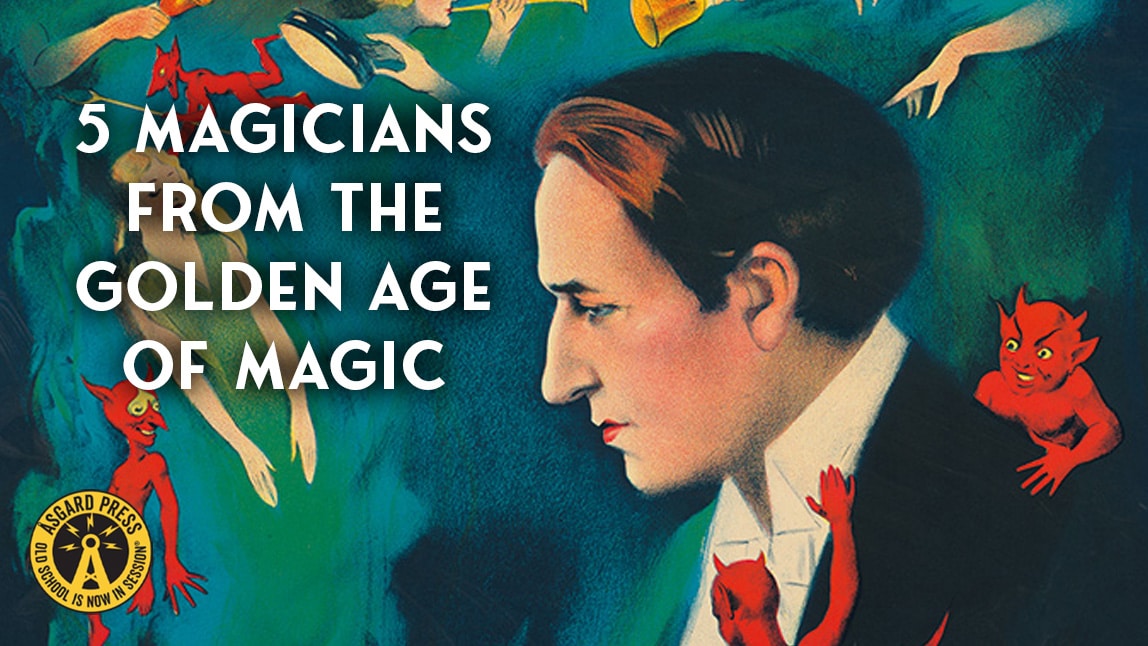Before the age of television and high-tech special effects, magicians and mentalists performed incredible feats of mystery, employing expert sleight of hand, misdirection, and a keen insight into the workings of the mind. From the 1880s through the 1930s, these illusionists, hypnotists, and mind readers gained international stardom and commercial success through their mesmerizing performances that had audiences asking, “how did they do that?” This era produced many notable performers whose legacy lives on today in modern magical artists. Here we explore five famous magicians from the Golden Age of Magic.
Harry Kellar, an Early Influence on Magicians
Harry Kellar, one of the most influential early magicians, was born Heinrich Keller in 1849, in Erie, Pennsylvania. After a dangerous and adventurous childhood riding the rails, Kellar settled in New York to finish his education and to eventually become a minister. However, he became captivated by magic after seeing a performance by Isaiah Harris Hughes and became Hughes’ assistant at just 12 years old, answering a newspaper ad. He changed the spelling of his name from Keller to Kellar to avoid confusion with another popular stage magician, Robert Heller.
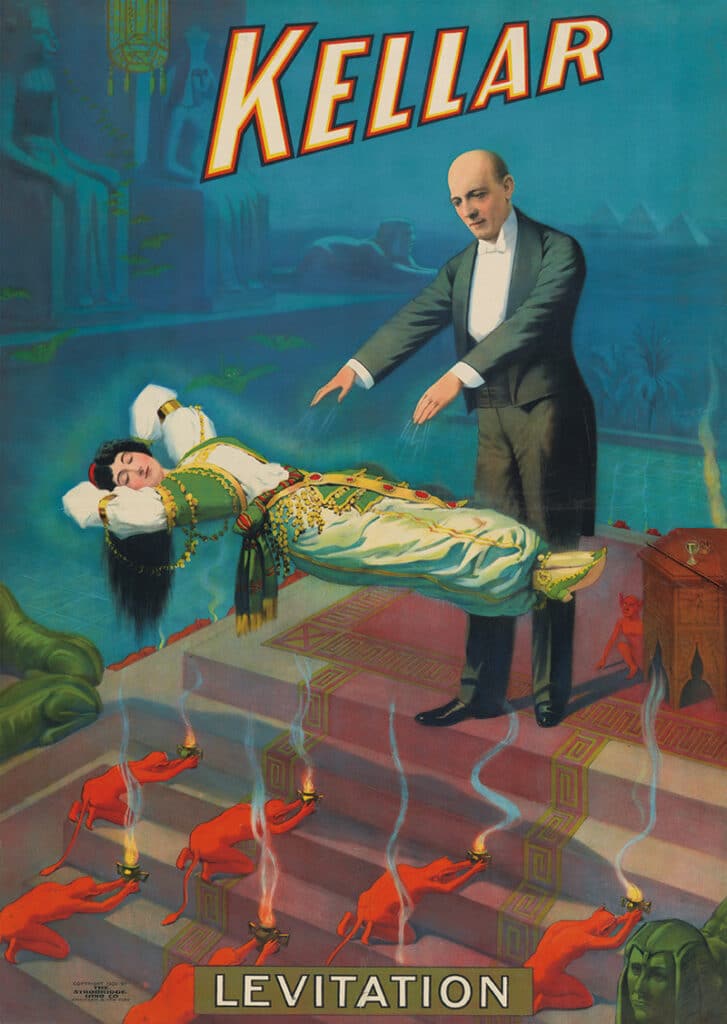
Kellar’s first attempt at a solo show, at the age of only 16, proved that he was not ready for the stage. He joined a traveling group of theatrical mentalists in 1869 and spent four years working with them, learning how to stage, transport, manage, and advertise a successful magical production. After a decade of performing in Europe and South America, Kellar returned to the United States and opened his own magic theater called Egyptian Hall after a famous performance hall in London, England.
Kellar’s solo shows as an adult included spectacular illusions such as “The Levitation of Princess Karnac” and the “Vanishing Lamp.” Kellar designed and constructed these illusions himself, sometimes with the help of businesses such as the Otis Elevator Company. These incredible tricks were built to take advantage of the audience’s perspective, using their fixed position to hide crucial parts of the structures. Combined with Kellar’s unparalleled talent for misdirection, these illusions in which people or items levitated or disappeared, delighted and amazed theatergoers. Kellar retired in 1908 and announced Howard Thurston as his show’s successor.
Newmann the Great, Mentalist and Mind-Reader
Magician Newmann, born Christian Andrew George Newmann, was a highly regarded illusionist and mentalist, or mind-reader and hypnotist, who captivated audiences during the early 20th century. Renowned for his skillful manipulation of cards and his uncanny ability to read minds, Newmann’s performances left spectators in awe across the United States and beyond. His legacy as a master of deception and entertainment continues to inspire magicians and mentalists to this day.
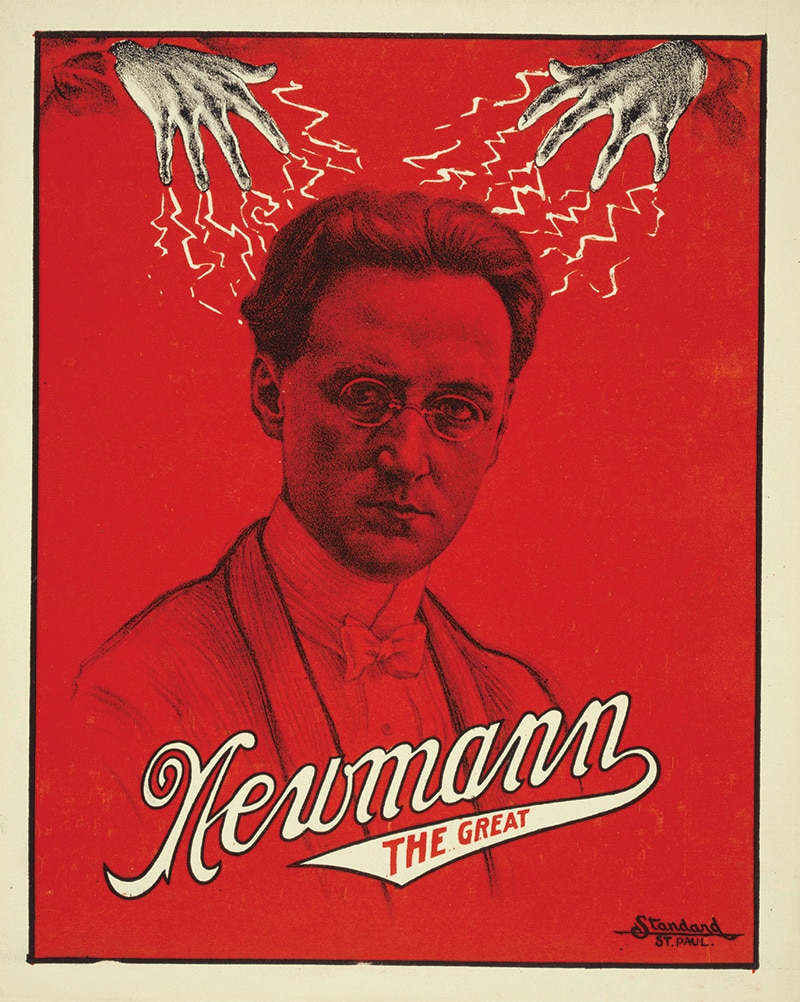
Newmann was born in 1880 in Minnesota and began performing magic as a child under the stage name Newmann the Boy Wonder. By age 13, Newmann had developed a successful hypnotic and mind-reading show. As an adult under the name Newmann the Great, he specialized in mentalist performances with a limited repertoire of high-end illusions including levitation and driving while blindfolded.
Newmann was also an avid collector of magic and mentalist literature. His library was one of the largest collections of magic-related books in America, with at least 1,600 tomes on his shelves. Newmann also shared his mind-reading tricks and deceptions with psychology students at colleges in Minnesota and North Dakota. Before his death in 1952, Newmann began donating his library to various organizations, including the University of Minnesota and Princeton University. Fellow illusionist Howard Thurston declared Newmann one of the greatest mentalists of all time.
Heaney the Great, Ambidextrous Card Trickster
Gerald Heaney, who performed as Heaney the Great, was born in Berlin, Wisconsin in 1899. He developed an interest in magic after meeting famous magician Harry Blackstone, Sr. Blackstone approached Heaney’s father at the family jewelry store to produce a piece of equipment for him, inspiring Heaney to study magic and develop a mail order magic supply business. Heaney, along with his wife Viola, also worked as one of Harry Houdini’s assistants in the 1920s after meeting Houdini backstage following a performance.
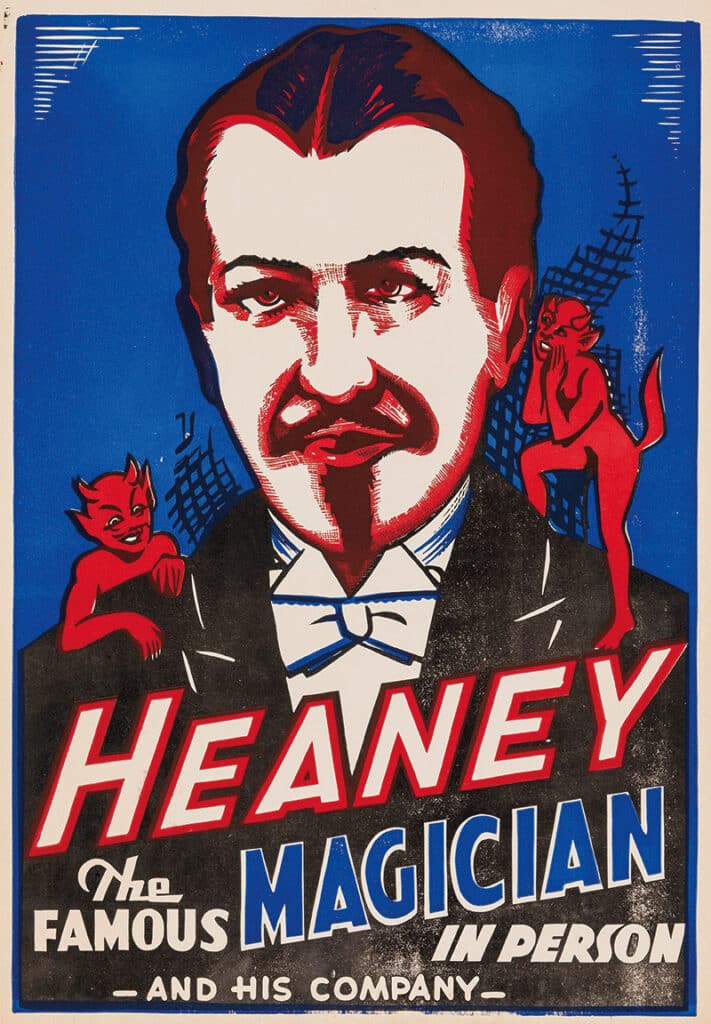
Heaney began developing his own solo show with a 15-minute card trick act that made good use of his ambidexterity. He gradually expanded the show, featuring illusions, ventriloquism, and hypnotism. His wife Viola, using the stage name Princess Aloiv, acted as his stage assistant and show supervisor, as well as providing the show’s music by playing the organ. Heaney the Great and the two-hour Heaney Magic Show toured throughout the United States, Canada, and Mexico through the 1950s, with occasional appearances on Midwest television stations. Heaney was a friend and admirer of fellow magician Howard Thurston and acquired Thurston’s props and equipment upon his death.
Following his retirement from touring, Heaney returned to operating his magic supply mail order business. He and Viola lived quietly in Wisconsin, performing privately only a handful of times each year. After Heaney’s death in 1974, the props and equipment from his acts were divided and sold off, some to David Copperfield’s private museum of magic show artifacts, which is accessible only to researchers, historians, and other magicians.
Grover George, Magician in Exile
Grover George, born in Zanesville, Ohio in 1877, became interested in magic at a young age and even put himself through college by performing magic shows. Among George’s early inspiration were magicians Harry Kellar and Howard Thurston. In the 1920s, George purchased a traveling show and equipment, Doc Nixon’s “Hong Kong Mysteries,” to upgrade his performance, which became greatly admired for the beauty and quality of the stage setting and props. With his combination of exceptional equipment, honed talent, and stage presence, George seemed poised to reach the top of the magical entertainment industry.
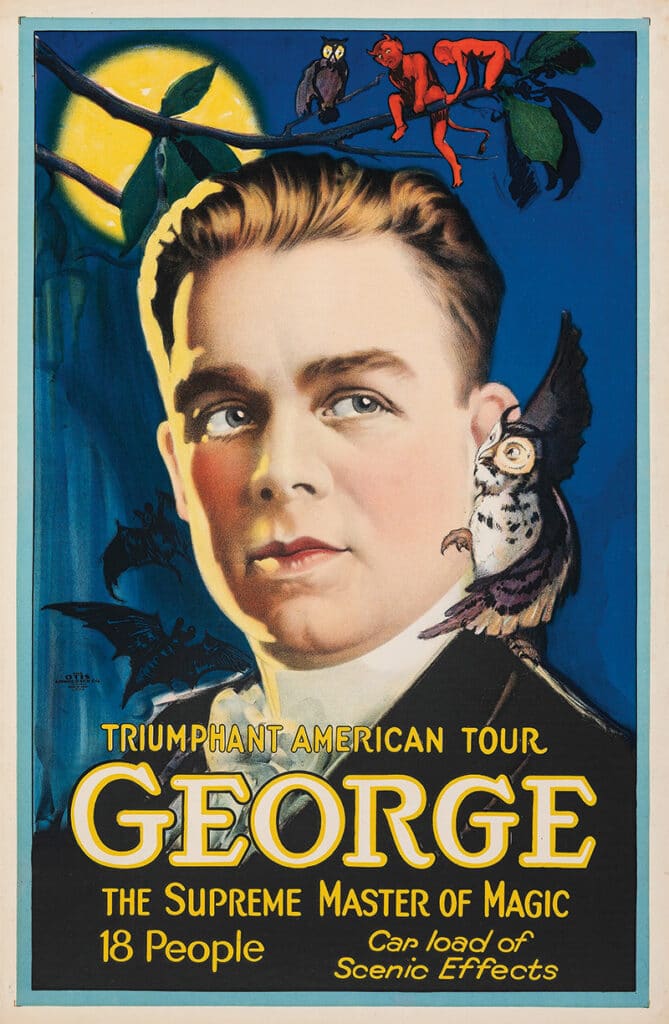
In 1908, magician Harry Kellar retired, after appointing Howard Thurston as his successor. When Kellar’s own props and equipment went up for auction after his death in 1922, George successfully outbid Thurston for several of the items, to which Thurston felt entitled as Kellar’s successor. Thus began a rivalry that was both professional and personal between George and Thurston, with Thurston exerting influence with theater owners and managers to blacklist George from performing in major venues in the United States.
George then took his show to South America in 1924, where he found great success, filling theaters to capacity in every major city. George decided to take the show back to the United States with a triumphant return tour in 1929, and had a lithographer print several thousand stunning color posters to advertise the performances. Upon his return, however, Thurston reignited their feud, and prevented George’s American tour from gaining much traction, limited as he was to second-rate venues and tent shows in fields. George eventually retired from magic to live in Brazil and sell theater projection equipment. The posters from George’s abbreviated U.S. tour were acquired by fellow magician Gerald Heaney and are still traded and admired today.
Thurston, the “King of Cards,” and Leader of Magicians
Howard Thurston, born in Columbus, Ohio in 1869, served as an apprentice to the renowned magician Harry Kellar before eventually surpassing his mentor in fame and popularity. As a child, Thurston ran away from home and was taken in by a family of performers from a traveling circus, which also happened to be the same circus that was hosting magician Harry Kellar’s show. Thurston, whose interest in magic had begun years earlier after seeing a performance by French magician Alexander Hermann, dedicated himself to a career as an illusionist, learning the trade from Kellar and applying the showmanship he learned from his life with the circus.
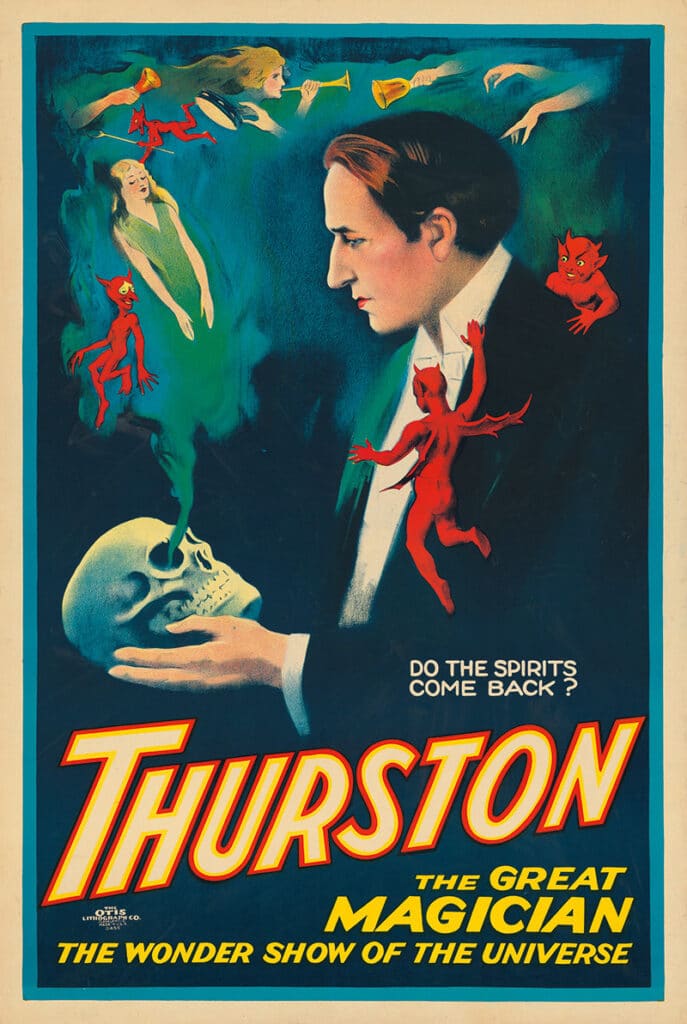
Thurston’s mastery of card tricks was legendary, probably due to his practice with sleight of hand from a very young age. He was known as the “King of Cards,” particularly for a trick he performed in which selected cards would “rise” from the deck, seemingly of their own accord. This trick was adapted by Thurston from the book Modern Magic by prolific magic author Professor Hoffman, the pseudonym of writer and illusionist Angelo John Lewis. Thurston also performed an extraordinary sleight of hand trick in which he made cards appear and disappear into thin air from his fingertips. Legend has it that Thurston learned this trick from New York City magic shop owner Otto Maurer, who himself learned it from a mysterious Mexican magician.
Thurston’s traveling show became famous for its sheer size and grandeur, with props and equipment filling multiple freight train cars. The stage sets and costumes were sumptuous and dazzling and his illusions, including vanishing horses and sawing a woman in half, were mesmerizing. The levitation illusion, famously known as “The Levitation of Princess Karnac,” and which he inherited from his mentor Kellar, was a centerpiece of his stage performances. Thurston successfully toured with his show for over 40 years, so it is hard to imagine why he feuded with Grover George for so long over venue bookings. Perhaps the true story of what passed between these two adversaries has been lost to magical history.
Are you fascinated by the early magicians that still inspire today’s illusionists? Check out our 2026 Vintage Magic Deluxe Calendar for a collection of 13 frame-ready prints of vintage magic show posters, accompanied by informative commentary!

